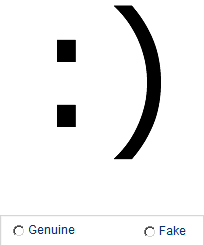Spot the fake smiley
Friday, June 15, 2007
You may have seen the web
site with the 10 minute experiment that tries to determine how good people are at spotting fake smiles.
I took the test and I could only spot 12/20 correct smiles (either genuine or fake). It seems like a disappointing score; I may as well had guessed them all, and easily got 10/20.
After I thought about the experiment, I realized there is an obvious caveat to the experiment: context.
As part of our social life, we don't just see heads smiling for 3 seconds at a time then determine who is trying to fake a smile.
Before and after every smile, there is a story behind it. Moreover, the act of smiling seems to come in pairs (or groups). What I mean is that most of the smiling we do is shared with someone. So if you find yourself smiling alone, it may not be considered "normal." For example, are you smiling right now and feeling embarrassed because people think you are crazy? I am not, but I'm alone in my living room. But if you are in a crowded place, I dare you not to smile.
So, I think the results of this test are inaccurate, skewed, and irrelevant. Our ability to tell genuine smiles from fake smiles has been honed throughout our evolution and through generations to culminate into the perfect genuine-smile-detector machines that we are. Otherwise, we would all be grumpy hermits.
Try it: if you simile at someone and this someone smiles back, I'm very confident you will be able to tell if the smile is genuine or fake.
Now, when it comes to smileys on emails, that's another story. Do you know what I mean? :)
And so, I created my own "Spot the Fake Smile" test (be advised, it's really, really hard):

Comments:
I just did that test. I scored 18/20. But this was after I read an article about the duchenne smile which explains how the muscles around the eyes need to be contracted in order for the smile to be fake. So even if I could clearly intuitively tell on some that the smile was fake/real on several I just evaluated the muscle activation without using my intution.
In one instance (the older man) I even thought, ok, his smile feels fake, but considering how the muscles are I will assume they consider it as real. And indeed, they categorized it as real.